Various: 12th to 15th April 2017
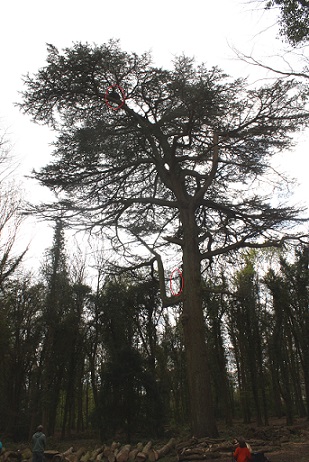
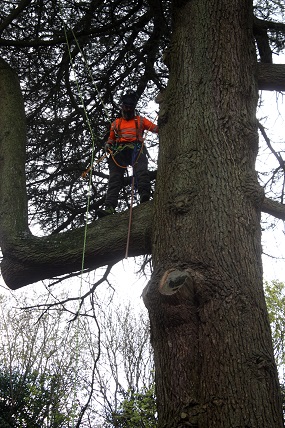
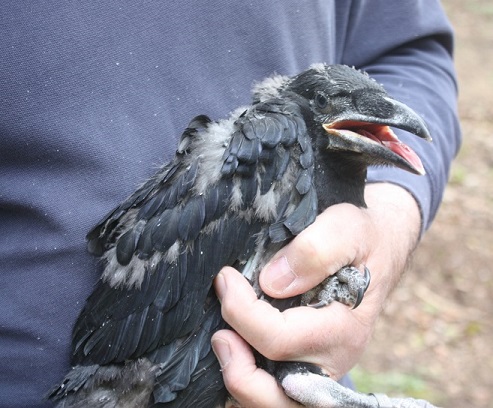
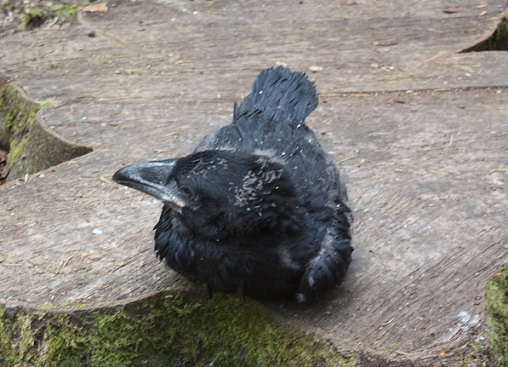
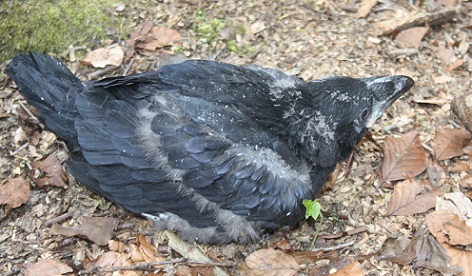





After the change of ownership last September, it has taken a while to get a session organised for Brown's Farm. The new tenant is keen for us to continue to work there but the site runs a shoot between September and the end of January and it is very exposed, being at the top of the hill south of Marlborough, with little cover. This has limited the opportunities to get there. Today genuinely was the only occasion when the weather, particularly the wind speed and direction, was favourable to a ringing session. I was joined by Charlie, Neil and Annie for the morning. This was the first visit to the farm for all three of them. We didn't have a large catch but all three of them got to ring their first Yellowhammers and Linnets.
The list for the day was: Blue Tit 5; Great Tit 1; Wren (2); Dunnock 4(1); Blackbird 2; Goldcrest 1; Chaffinch 1; Linnet 7; Yellowhammer 4(1). Totals: 25 birds ringed from eight species; four birds retrapped from three species, making 29 birds processed from nine species.
Virtually every species was showing signs of preparation for breeding, particularly a number of female Linnets with brood patches already developing. We did catch two birds that we could not ring: Pheasant and Red-legged Partridge. Pheasant are strictly not to be ringed: there are so many released every year, to be shot, that the remnants are not classified as true wild birds. Red-legged Partridge can be ringed with the specific permission of the BTO but, as this site rears them for the winter shoots, I am confident there are no circumstances under which the BTO would allow it. Still, we got a nice photograph of a smart bird:
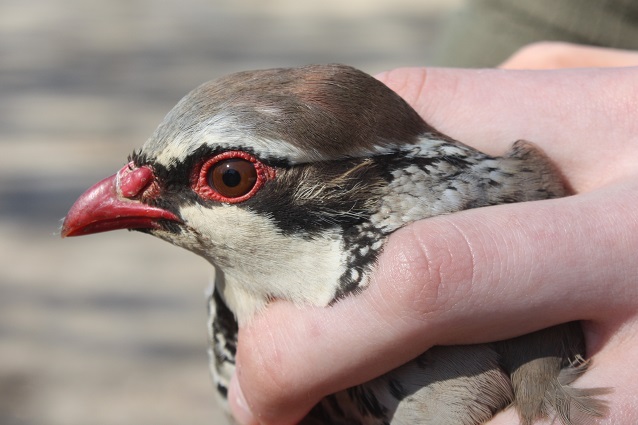
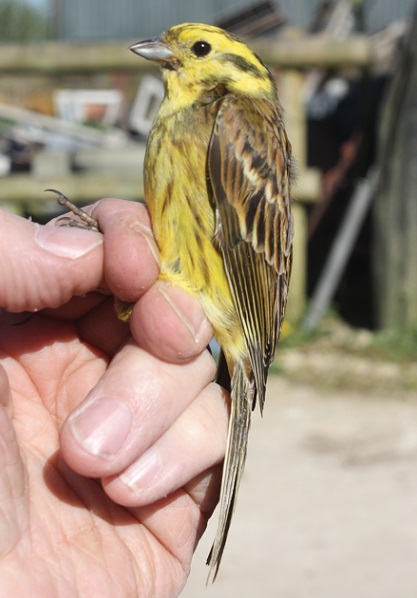
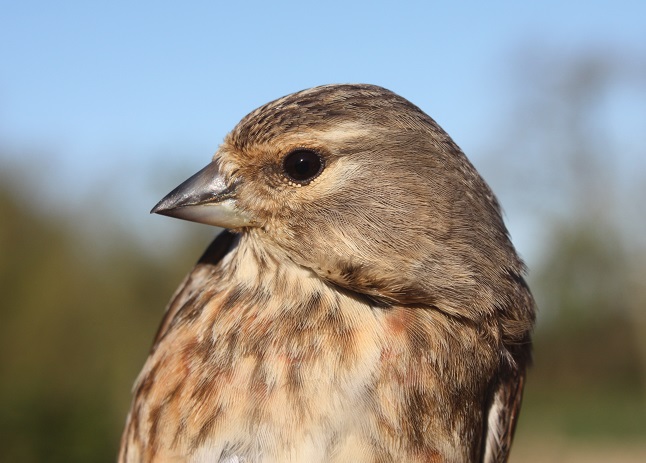 ST/CS/NS/AH
ST/CS/NS/AH
With lots of reports of Spring migrant arrivals all over the internet, we ran a session at Lower Moor Farm this morning to see what has arrived there so far. I was joined for the day by Neil and Ellie. Neil's morning started off brilliantly, with great views of an Otter swimming across Mallard Lake (some of us were too busy putting nets up to watch Otters  ). The morning started off clear and cold at 6:00, but warmed up quite quickly and, by 9:00 it was a very pleasant morning.
). The morning started off clear and cold at 6:00, but warmed up quite quickly and, by 9:00 it was a very pleasant morning.
The catch delivered our first Willow Warblers of the year:
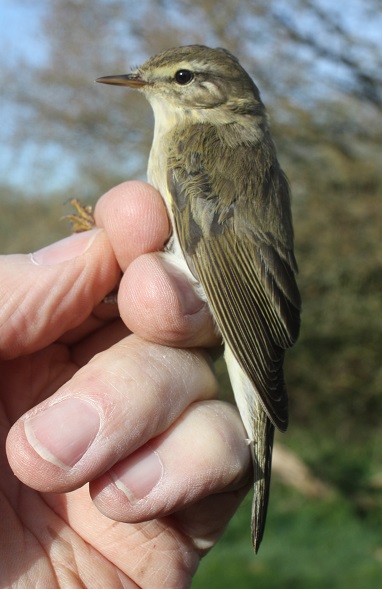
We caught four of them: including one that had a wing length of 72mm. According to Svensson (our Bible for Passerines), this is the absolute maximum length recorded for a Willow Warbler wing and is only to be found in specimens recorded in Sweden. Still, Svensson is in need of an update. The more recent translation from the French, of the book by the author Laurent Demongin, "Identification Guide to Birds In The Hand", has an absolute extreme of 76mm for Willow Warbler.
In addition, we had our first two female Blackcaps of the year: one of them was already sporting a well-defined brood patch. The overall list for the day was: Blue Tit (2); Great Tit (1); Long-tailed Tit (1); Wren 2(1); Dunnock 1(1); Robin 1(3); Song Thrush (1); Blackcap 5; Chiffchaff 3(3); Willow Warbler 4; Goldcrest (1); Bullfinch 1; Reed Bunting 1. Totals: 18 birds ringed from eight species; 14 birds retrapped from nine species, making 32 birds processed from 13 species.
In addition to our catch, we were treated to sightings of Kingfisher, Kestrel, Sparrowhawk and Ravens. We had our first Orange Tip, Peacock and Small Tortoiseshell butterflies but the one that surprised us most, seen along the Heron ride, was a very early Speckled Wood. ST/EJ/NS
Jonny and I ran a session at Somerford Common on Wednesday morning, prior to Jonny's expedition to Madagascar with his UWE colleagues. I know he is really looking forward to getting to ring some exotic species out there but wasn't disappointed in the small catch we had on Wednesday either.
The list for the morning was; Nuthatch 1; Great Tit (2); Coal Tit 1(1); Long-tailed Tit 4(3); Wren 1; Dunnock 3(1); Robin 2(1); Blackcap 1; Chiffchaff 8; Goldcrest 2; Chaffinch 1; Bullfinch 1. Totals: 25 birds ringed from 11 species; eight birds retrapped from four species, making 33 birds processed from 12 species. The undoubted highlight was our first Blackcap of this Spring, plus another eight Chiffchaffs.
Saturday morning saw me with Steph, Charlie and Neil at Red Lodge. The first thing to say is that, since my note to the residents about the vandalism to my feeding station and the installation of covert surveillance by the Forestry Commission, the bird table has remained unmolested for a full month now. Hopefully that is an end to that nonsense. We only had a small catch of 20 birds this morning but, with Steph and Neil only just starting their extracting, and none of them having been available for the last couple of weeks, it was a good session to ease them back in gently to working with the birds. The list for the morning was: Blue Tit 2; Great Tit 1(2); Long-tailed Tit 1; Wren 1(2); Robin (1); Blackcap 1; Chiffchaff 5(1); Goldcrest 1; Chaffinch 1; Goldfinch 1. Totals: 14 ringed from nine species; six retrapped from four species, making 20 birds processed from 10 species. There were highlights: the Goldfinch is the first ever caught in Red Lodge. Since the thinning operation in 2015, this wood has begun to turn up a greater variety of birds, the star was obviously the Spotted Flycatcher last Autumn, but, as well, we have been able to add both Lesser Redpoll last December and, now, Goldfinch to the list.
Although we did not catch any in these sessions, we could map three separate Marsh Tit territorities with calling males in each of the sites. This is pretty encouraging and, if we have a decent Spring and Summer, we might see a further welcome increase in the number of Marsh Tits in the Braydon Forest. ST/JC/SB/CS/NS
It is that time of the year where the winter feeding flocks of resident birds have broken up, some of the winter flocks are still around and summer migrants are on their way in. To put it another way: it can be pretty quiet. The Firs this morning lived up to that expectation. We had a team of four: Jonny, Ellie and Annie joined me.
There has been a lot of work done in the Firs, continuing on from the opening up of the central glade and the digging of the wildlife ponds three years ago, opening up new rides and glades, and the plan for ringing there over the summer is to start testing to see if these changes have had any impact on what is using the wood. As (previously blogged) we caught two juvenile Spotted Flycatchers there in August last year, I will be interested to see if that was just an on passage drop in, or if there is something more exciting going on.
The list for today was; Treecreeper 1(1); Blue Tit 2(2); Great Tit 5(3); Marsh Tit (2); Wren 1(2); Robin (1); Chiffchaff 8; Chaffinch 1; Goldfinch 1. Totals: 19 birds ringed from seven species; 11 retrapped from six species, making a total of 30 birds processed from nine species. Highlights from the catch were: the recapture of two Marsh Tits ringed last autumn; a nice early group of Chiffchaffs and an aged Treecreeper.
The Treecreeper was one of the first ringed by me at the Firs, on the 10th March 2013. It was ringed as an adult, which means that it has survived for four years since ringing (it has not been retrapped in between times) but was at least eighteen months old at the time of ringing. Not bad for a bird with a normal lifespan of two years, but a way to go before it reaches the record of eight years and eighteen days. It still looks pretty smart to me:
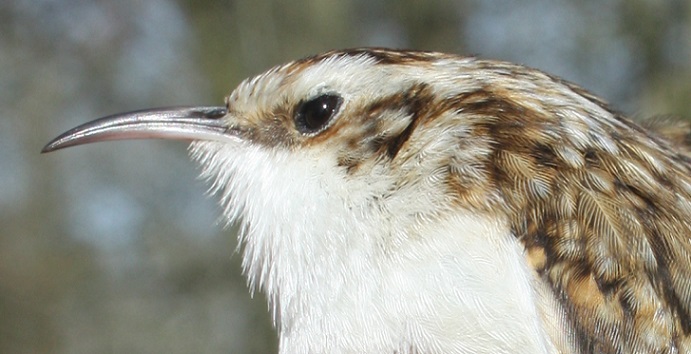
Of the eight Chiffchaffs caught, four of them had what we call pollen horns:
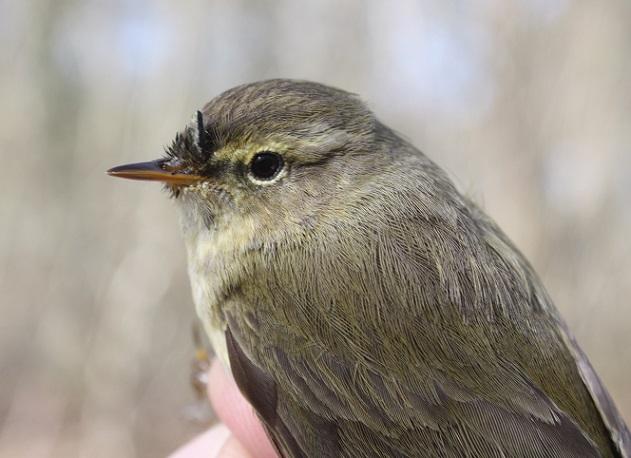
Jonny has a hankering to collect these and try to identify which plants the pollen comes from. If anybody happens to catch any Chiffchaffs with the aforesaid pollen horns and can separate the pollen from the bird without damaging it, Jonny would be very grateful. ST/JC/EJ/AH
It has been a bit of a busy week with three sessions. Monday's session was to replace the scheduled meeting at Ravensroost Woods on Sunday. Fortunately Ellie could join me for this session and we had a reasonable catch of 37 birds. The list for the day was: Great Spotted Woodpecker 1(1); Nuthatch 1(1); Blue Tit 3(4); Great Tit 11(2); Coal Tit 1; Long-tailed Tit 1; Wren 1(1); Dunnock (2); Robin (1); Goldcrest (1); Chaffinch 1; Goldfinch 4. Totals: 24 ringed from 9 species; 13 retrapped from 8 species, making 37 birds processed from 12 species.
Wednesday was my monthly Help4Heroes session at Tedworth House. I started late, arriving at 7:00, to find that none of the feeders had been topped up, so I was expecting one of the lighter sessions. Fortunately, I had some feed in the car and topping up the feeders helped improve the catch somewhat. The day turned into a bit of a stunner. Many thanks to Jack Daw for all his help setting up the nets. Okay, I only caught 28 birds but it was an excellent session for three very good reasons: I had a lovely little ringing session with a group of recovering soldiers. It is fascinating to see how they respond to being in close proximity to a tiny bird. Two of them got to hold and release the last two birds of the session. It is interesting to see how they respond when asked if they would like to hold and release a bird. It is like the old jokes on volunteering: watching the majority step back to leave those who are slower to react. The two other reasons were both to be had on my second round of the day. First, I caught my fourth Mistle Thrush on the site, the third to be ringed there. Given how few are caught and ringed each year, this is a remarkably productive site for them. As you may remember from last month's report, there has been an over-wintering Black Redstart at Tedworth House. It has been feeding up on hibernating ladybirds. Approaching the net by the vegetable / herb garden I saw what I initially took to be a Robin in the net but, as I got closer, I saw a distinctive red tail. There is only one over-wintering red-tailed bird in the UK: the Black Redstart. Apologies for the terrible photographs but my camera decided to throw a wobbler and I had to take them on my mobile, which was just about out of charge and couldn't fire the flash. News of the Black Redstart drew quite a crowd coming to see this uncommon bird.
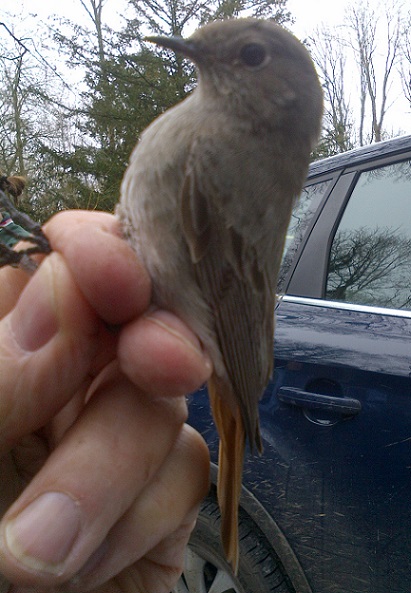
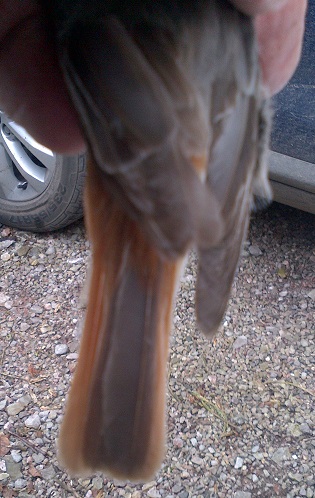
As far as I have managed to find out, this is the fifth one of the species ringed in Wiltshire and the first since 2008. The list for the day was: Nuthatch 1(1); Blue Tit 6(4); Great Tit 2(2); Coal Tit 1(2); Wren 1; Dunnock 1(2); Robin 1; Black Redstart 1; Mistle Thrush 1; Blackbird (1); Chaffinch 1. Totals: 16 ringed from 10 species; 12 retrapped from 6 species, making 28 birds processed from 11 species.
Thursday was a special session, arranged with Rachel Bush from the Wiltshire Wildlife Trust, to work with the Youth Well-Being group. It was a late start with the net set for a 9:30 start. We only caught ten birds but the youngsters had a cracking time with what we caught, From initial consternation and some disgust, they soon got into the session, with lots of sensible questions and enthusiasm for being taught the ageing and sexing of the birds caught. All of the birds were, unusually, new catches. They were: Blue Tit 2; Great Tit 3; Dunnock 1; Chiffchaff 1; Chaffinch 1; Goldfinch 1; Reed Bunting 1. Total 10 birds processed from eight species. To top it all off, I had a gang of willing helpers for the take down, which meant we were done in half the time. After the last time I did one of these sessions I got a new trainee out of it - and I have had an enquiry this time as well. ST/EJ/JD
A lovely session in Webb's Wood this morning. With two of my more inexperienced trainees in attendance (Annie has only just started extracting; David has just had a couple of taster sessions, and I started him ringing birds today) I only set three nets (2 x 18m + 1 x 12m) around the feeding station and we were rewarded by a catch of 40 birds from 13 species. The catch came in regular intervals, giving plenty of time for me to spend with David, helping him to develop the techniques he will need in his ringing career.
We caught four Great Spotted Woodpeckers: equalling the largest catch of this species that I have had in one session. One of the woodpeckers we were unable to sex. Although the nape was black, there was a smattering of glossy red feathers throughout the nape area. The texts acknowledge the existence of the situation but focus on what it means for ageing the bird (nothing, as the texts have it) and say nothing about the sex of the bird. Unfortunately, we didn't manage to catch the Lesser Spotted Woodpecker that sat and called for about 10 minutes in the trees just behind our ringing station. The list for the day was: Great Spotted Woodpecker 4; Nuthatch 2(1); Blue Tit 5(1); Great Tit 4; Coal Tit (4); Marsh Tit (2); Long-tailed Tit 1(1); Robin (1); Blackbird 1; Goldcrest 1; Chaffinch 4; Lesser Redpoll 3; Siskin 5. Totals: 30 birds ringed from 10 species and 10 birds retrapped from six species.
We caught another four Chaffinch but, unfortunately, a fifth had to be released without ringing, as it was suffering with the Fringilla papilloma virus. ST/AH/DW
A second session in a Forestry Commission wood in the Braydon Forest where I have recently had to move the feeding station, produced another good and varied catch. Unlike Red Lodge, I had to move the feeding station because the path on which it was previously set is now impassable: a combination of wet weather and horses has churned it into a real swamp. Also unlike Red Lodge, there have been no subsequent vandalism problems.
I was joined for this session by Jonny, Steph and her daughter Lillie. Lillie is a delight and, at a mere seven years of age, is knowledgeable of the birds we process and is very confident in her handling of them (well, all except the Great Spotted Woodpecker, anyway). Definitely a ringer of the future. However, her major contribution to the day was her discovery that the rulers we use for measuring the wings (which have a small rectangular stop at the 0 point of the rule) could be made to walk across our ringing table if placed on the end stop. We have a new game for quiet sessions.
The wood offered decent shelter from what wind there was, the weather was dull and overcast for most of the session, almost perfect bird ringing conditions. We set three net rides, anitcipating that most of the action would be around the feeding station. 72 metres down the main track and 12 metres behind the bird feeders, to catch anything coming through the wood to visit the station. The list of birds caught was: Great Spotted Woodpecker 1(1); Nuthatch (1); Treecreeper 1; Blue Tit 8(6); Great Tit 3(4); Coal Tit 10(6); Marsh Tit (2); Long-tailed Tit (8); Dunnock (2); Robin 4; Blackbird (1); Chaffinch 3; Goldfinch 1; Siskin 2; Lesser Redpoll 1. Totals: 34 birds ringed from 10 species; 31 birds retrapped from nine species, making 65 birds processed from 15 species.
There were a number of interesting things arising from the catch. It is known that Long-tailed Tits hang around in family groups. We caught numbers JJP468 to JJP473 inclusive. All were ringed on the 24th August last year at Somerford Common. We also caught consecutively numbered adult male and female Great Tits, originally ringed in December last year, adjacent to each other in the same net. I had the same occurrence at Red Lodge yesterday, where both were originally ringed in March of last year, and I have seen it before in Ravensroost. I have searched the literature and, although male Great Tits are said to be usually monogamous within the breeding season, there is nothing about the maintenance of the pair bond outside the breeding season. Looks as though there might be a study and a paper in this. Of course, this is the sort of thing that can only be investigated through the ringing scheme, as it is the only permanent way of identifiying individuals.
We ringed our second (and third) Siskin for the site, a male and a female (the first was back in November 2013), plus our second Goldfinch for the site (the first was in November 2015), our sixth Great Spotted Woodpecker of the year, and a Treecreeper that, for once, looked comfortable when photographed (too often they adopt a hunched posture that just doesn't look right). A few photographs from today's session follow:
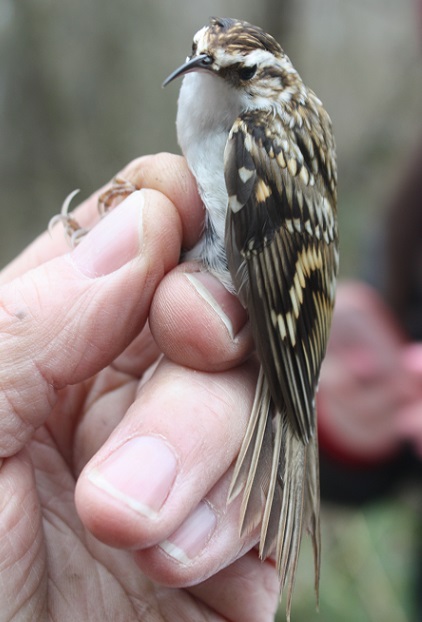
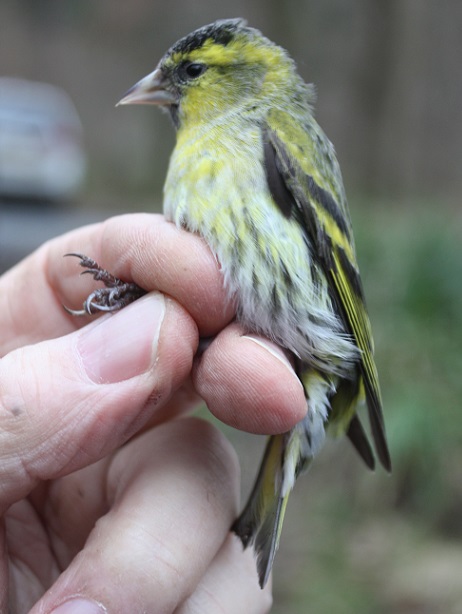
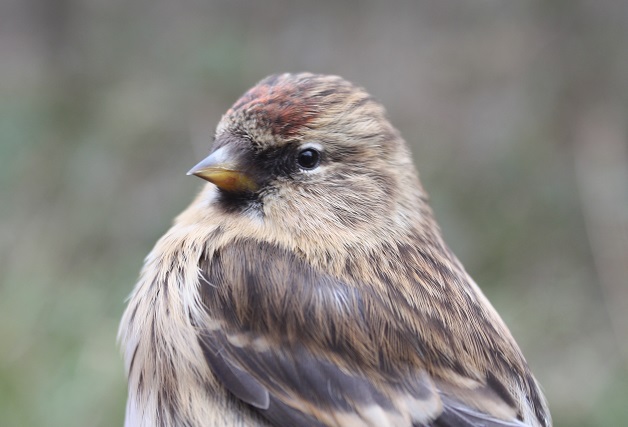 ST/JC/SB/LB
ST/JC/SB/LB